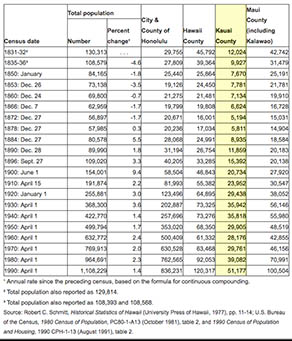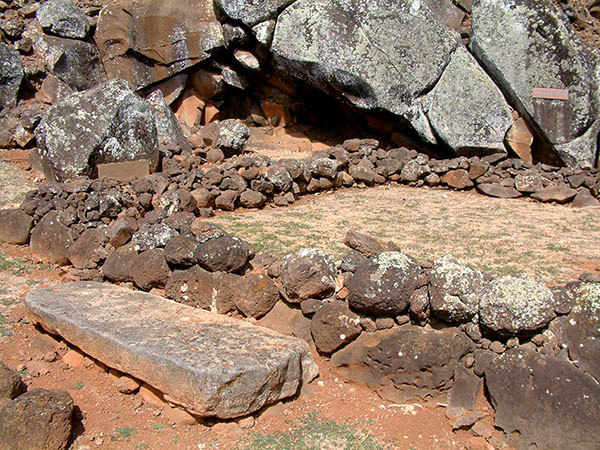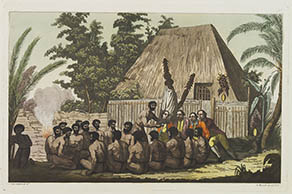Introduced Diseases
|
|||||||||||
“It’s almost certain that Cook's men introduced syphilis and gonorrhea to Hawai‘i on Kaua‘i or possibly on Ni‘ihau,” Andy explains. “After Cook’s ship was blown off shore from Kaua‘i, he visited Ni‘ihau where his men went ashore with orders to return before nightfall. But the surf came up and the men were forced to remain on shore over night. Both there and on Kaua‘i Hawaiian women were very aggressive in their efforts to sleep with the haole sailors, and of course, the sailors were happy to accommodate them, despite orders to stay away from the women. "A year later, when the expedition returned to the islands after visiting the Pacific Northwest, Cook found that venereal disease was widespread on Maui and on Hawai‘i island. Since there was no evidence of the disease on Kaua‘i when they first arrived, Cook was forced to conclude that his men were responsible for its introduction. A few historians have argued that venereal disease could not have spread that quickly across all the islands and believe that it had already found its way to Hawai`i earlier. I doubt it. 
“From the very beginning Hawaiians died from venereal disease, but venereal disease is, in general, a slow killer. The impact that venereal disease had on Hawaiians was much more important in the numbers of children that weren't born, and that is something that happens over time as the result of sterility. By the middle of the 19th century, maybe even before then, venereal disease was close to universal among Hawaiians. That didn't mean that everybody had venereal disease or that venereal disease had the same impacts on everybody, but it did mean that lots and lots of women were sterile and thousands of children were not born. Many observers, including missionaries, were astounded by the very low birthrates among Hawaiians—not just the high rates of death. “Of course Hawaiians also died from many other diseases introduced by foreigners, but most of those diseases were probably not brought by the early explorers because the long voyages they took acted as quarantines. By the time the explorers arrived there were no longer active cases of influenza or smallpox or other communicable diseases among their crews. It was only after about 1800 when shorter trips between China and Hawai`i started that these new killers arrived. I think it's safe to say that at least 80% of Hawai`i's population disappeared in the century following Cook's visit. “Here is a Bushnellian theory: Why were the Kaua‘i women so intent upon having intercourse with these foreigners? When they get to the Big Island at Kealakekua Bay, the women are basically throwing themselves at the haole men as they had on Kaua‘i. And by this time, Cook had said, ‘Well venereal disease is here, they can go at it.’ He didn’t encourage them, he didn’t like it, he didn’t say he didn’t like it, but that’s what happened.
“But the question then is, why are the Hawaiian women throwing themselves at the haole sailors? I think that what is going on here is that marriage or mating was a way of increasing one’s status in Hawaiian society. Although there is no clear statement in Cook’s journals that Hawaiians on Kaua‘i thought Captain Cook was a god—was Lono—they clearly understood that he was godly—a man of great prestige and power and status, like an ali‘i. And in Hawaiian society, the guys that hung around with the chiefs were powerful people who had great status. And so by having intercourse with the guys that hung around Captain Cook, the women got status, especially if they could conceive a child. “After Captain Cook visited Kaua‘i and sailed north to the Pacific Northwest and then came back to Hawai‘i, he went to Kealakekua Bay where he was killed. But his ships returned to Kaua‘i the following year. They came back to get water and supplies and things like that. At first they found the Hawaiians very unfriendly this time. Although the chiefess Ka-maka-helei calmed things down after a while and helped them get some water. “But one of the things that was most interesting to several members of Cook’s crew, who wrote about this in their journals, was that the women came out to the ships, apparently with their husbands—they called them their "husbands"—and while women sat in the canoes, the husbands climbed up onto the ships and they secreted little bundles of kapa in a variety of hiding places. And what they were, the kapa was wrapped around the piko, the umbilical cords of the children who had been conceived the previous year as a result of their love-making with the sailors. And again, we’re reading a little bit into it—nobody did DNA tests to discover for sure that that these were children of the Englishmen. But the sailors assumed that. “And we know that Hawaiians believed that the piko were the connecting link between children and their ancestors and often hid the piko away to protect that connection. The point was not that Hawaiian men were lousy lovers—they weren’t—but that having children by them would not increase their status the way having children with associates of Captain Cook would." |
|
|||||
|
|||||
|
|||||





